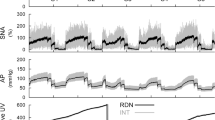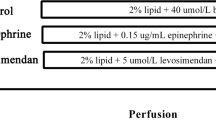Summary
Exogenous bradykinin was administered to pigs in which an experimental infarction was evoked by ischemia and reperfusion. Ischemia (45 min) was induced in a closed-chest model with a balloon catheter in the left anterior descending artery, reperfusion by deflating and removing the balloon. The pigs were treated with saline (n = 11) or bradykinin (0.1 mg/kg in 30 min) infusion (n = 10) during the last 15 min of the ischemic period and the first 15 min of reperfusion.
During ischemia, heart rate increased in the saline group to 120 ± 9 % of the initial value (p < 0.05) and in the bradykinin group to 155 ± 13 % (p < 0.05). After reperfusion, the rate-pressure product was increased in both groups. The increase of arterial creative kinase levels was significantly less in the bradykinin-treated group. However, the catecholamine and purine levels were increased, as was the plasma renin activity when compared with the saline group.
Two weeks after the infarction, six pigs had died in each group. In three out of five surviving saline-treated pigs and one out of four surviving bradykinin-treated pigs, a sustained ventricular tachyarrhythmia was inducible after programmed electrical stimulation.
In conclusion, although systemically administered bradykinin caused a temporary increase in myocardial ischemia, it did reduce the (enzymatic indices of) infarct size. Therefore, the beneficial effects, previously found for ACE-inhibitors might at least partially be related to the potentiation of endogenous bradykinin.
Similar content being viewed by others
References
Braunwald E (1987) The path to myocardial salvage by thrombolytic therapy. Circulation 76(Suppl 2):112–117
Ertl G, Kloner RA, Alexander RW, Braunwald E (1982) Limitation of experimental infarct size by an angiotensin-converting enzyme inhibitor. Circulation 45:40–48
Forman MB, Puett DW, Virmani R (1989) Endothelial and myocardial injury during ischemia and reperfusion: pathogenesis and therapeutic implications. J Am Coll Cardiol 13:450–459
van Gilst WH, de Graeff PA, Kingma JH, Wesseling H, de Langen CDJ (1984) Captopril reduces purine loss and reperfusion arrhythmias in the rat heart after coronary occlusion. Eur J Pharmacol 100:113–117
van Gilst WH (1989) Protection of the myocardium against postischemic reperfusion damage. J Cardiovasc Pharmacol 14(Suppl 9):S49–S54
de Graeff PA, van Gilst WH, Bel KJ, de Langen CDJ, Kingma JH, Wesseling H (1987) Concentration dependent protection by captopril against myocardial damage during ischemia and reperfusion in a closed-chest pig model. J Cardiovasc Pharmacol 9(Suppl 2):S37–42
Kimura E, Hashimoto K, Furukawa S, Hayakawa H (1973) Changes in bradykinin level in coronary sinus blood after the experimental occlusion of a coronary artery. Exp Lab Rep 85(5):635–647
Kingma JH, Louwerenburg HW, Six AJ, van Gilst WH, de Graeff PA, Wesseling H (1989) Concomitant use of captopril during thrombolytic therapy in acute myocardial infarction. In: Sonnenblick EH, Laragh JH, Lesch M (eds) New frontiers in cardiovascular therapy: Focus on angiotensin converting enzyme inhibition. Excerpta medica, Princeton USA, pp 277–285
de Langen CDJ, de Graeff PA, van Gilst WH, Bel KJ, Kingma JH, Wesseling H (1989) Effects of angiotensin II and captopril on inducible sustained ventricular tachycardia two weeks after myocardial infarction in the pig. J Cardiovasc Pharmacol 13:186–191
Linz W, Schölkens BA (1987) Influence of local converting enzyme inhibition on angiotensin and bradykinin effects in ischemic rat hearts. J Cardiovasc Pharmacol 10(Suppl 7):S75–S82
Lucchesi BR (1990) Myocardial ischemia, reperfusion and free radical injury. Am J Cardiol 65:141–231
Opie LH (1989) Reperfusion injury and its pharmacological modification. Circulation 80:1049–1062
Pepine CJ (1989) New concepts in the pathophysiology of acute myocardial infarction. Am J Cardiol 64:213–813
Rochette L, Ribuot C, Belichard P, Bril A, Devissaguet M (1987) Protective effect of angiotensin converting enzyme inhibitors (CEI): captopril and perindopril on vulnerability to ventricular fibrillation during myocardial ischemia and reperfusion in the rat. Clin Exp Hypertension Ther Pract A9(2&3):365–368
Schölkens BA, Linz W, König W (1988) Effects of the angiotensin converting enzyme inhibitor, ramipril, in isolated ischaemic rat heart are abolished by a bradykinin antagonist. J Hypertension 6(Suppl 4):S25–S28
Simson MB (1981) Use of signals in the terminal QRS complex to identify patients with ventricular tachycardia after myocardial infarction. Circulation 64:235–242
Tio RA, van Gilst WH, Rett K, Wolters K, Dietze GJ, Wesseling H (1990) The effects of bradykinin and the ischemic isolated rat heart. Horm Metab Res, G Thieme Verlag, Stuttgart, pp 85–89
Tio RA, de Langen CDJ, de Graeff PA, van Gilst WH, Bel KJ, Wolters GTP, Mook PH, van Wijngaarden J, Wesseling H (1990) The effects of oral pretreatment with zofenopril, an angiotensin converting enzyme inhibitor in early reperfusion in the pig. Cardiovasc Drugs and Therapy 4:695–704
Tobé TJM, de Langen CDJ, Tio RA, Bel KJ, Mook PH, Wesseling H (1990) In vivo effect of bradykinin during ischemia and reperfusion: improved electrical stability two weeks after myocardial infarction in the pig. J Cardiovasc Pharmacol (in press)
Westerink BHC (1983) Analysis of trace amounts of catecholamines and related compounds in brain tissue: a study near the detection limit of liquid chromatography with electrochemical detection. Liquid Chrom 6:2337–2351
Yusuf S (1987) Interventions that potentially limit myocardial infarct size: overview of clinical trials. Am J Cardiol 60:11A-17A
Author information
Authors and Affiliations
Rights and permissions
About this article
Cite this article
Tio, R.A., Tobé, T.J.M., Bel, K.J. et al. Beneficial effects of bradykinin on porcine ischemic myocardium. Basic Res Cardiol 86, 107–116 (1991). https://doi.org/10.1007/BF02190543
Received:
Issue Date:
DOI: https://doi.org/10.1007/BF02190543




